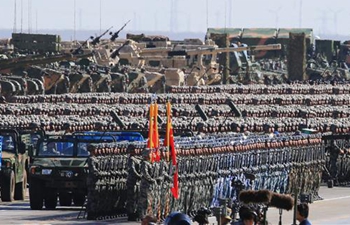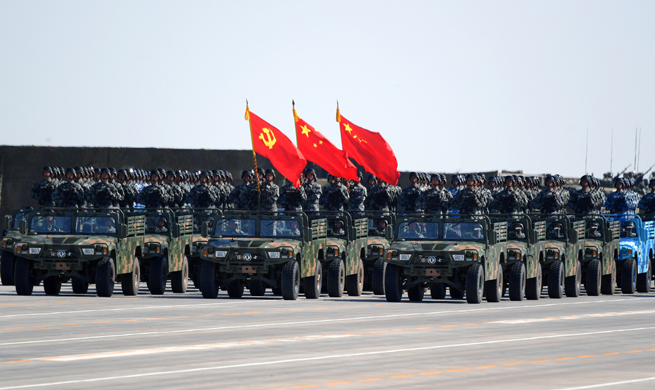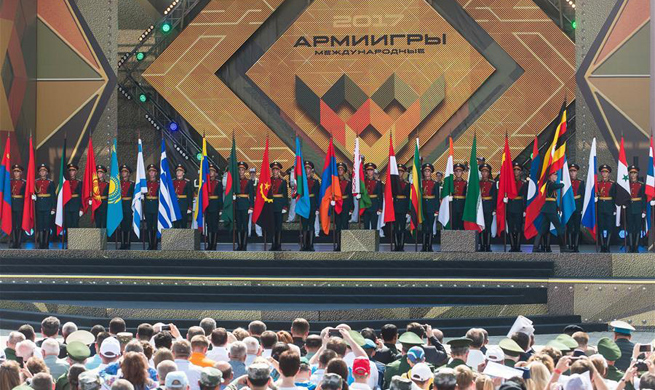by Julia Pierrepont III
LOS ANGELES, July 30 (Xinhua) -- Hollywood's love affair with anything "auto" shows no signs of braking. A rear-view mirror look at July's box office grosses shows three car-themed movies racing into the Top Ten: "Transformers: The Last Knight" (128 million U.S. dollars), "Cars 3" (146 million U.S. dollars), and "Baby Driver" (89 million U.S. dollars).
Cars. They are woven into the very fabric of human civilization. While the rest of the world was slow to warm to this disruptive new technology, Americans - in typical pioneering spirit - have embraced it with a vengeance ever since Henry Ford's revolutionary moving assembly line made them affordable for the masses. And though China went on to become the largest automobile manufacturer on earth, by far the longest love affair with the automobile has been with America - Hollywood in particular.
Iconic American TV host, Jay Leno, whose 150 piece, multi-million dollar car collection is legendary, says, "Cars are part of the American Dream, and Hollywood gets that."
Automobiles have been the "go to" device for thrills, chills, action and intimacy. Hollywood starts our engines young, with family classics like Dick Van Dyke's "Chitty Chitty Bang Bang" (1968), then rolls into Pixar' s lovable 3D animated phenomenon, "Cars", "Cars 2", and "Cars 3", and picks up speed with the "Herbie - Love Bug" tweener franchise (1968-2005).
Our car mania was further fueled by films that inspired a generation of teenagers packin' a learner's permit and yearning for badass "roll" models. Low budget, Oscar-nominated "Smokey and the Bandit" (1977) peeled out with a whopping 127 million U.S. dollars in the box office and TV's "Dukes of Hazzard," "Knight Rider," and "Chips" ruled the metaphoric streets all through the 1980's.
Hollywood can effortlessly shift gears, accelerating into more personal, coming-of-age movies, like George Lucas' career-launching classic, "American Graffiti" (1972) and Penny Marshall's "Riding in Cars with Boys" (2001).
The automobile is inextricably synchro-meshed deep into American culture. Given their importance in our everyday lives, is it any wonder that nothing grabs our attention faster than a catastrophic car crash?
Aykroyd and Belushi smashed 70 cars in the "Blues Brothers" (1980); "Need For Speed" (2014) was purported to pile up a collector' s ransom of tortured steel, ranging from a Lamborghini Sesto Elemento, a GTA Spano, Koenigsegg Agera R, Saleen S7 twin-turbo, Bugatti Veyron Super Sport, to a lean, mean McLaren P1. And it' s no surprise that Paul Haggis drove off with a "Best Picture" Oscar for "Crash" (2004).
Some movie cars, destined for gearhead glory, have become the stuff of legend: James Bond's tricked out Aston Martin D85; Steven McQueen's 1968 Mustang GT 390 Fastback in "Bullitt"; "Christine's" 1958 Plymouth Fury; "Back To The Future's" 1981 De Lorean DMC-12; "Starsky & Hutch's" 1976 Ford Gran Turino; and "Smokey and the Bandit's" winner-takes-all apex muscle car, the 1977 Pontiac Trans Am.
Women have put their own spin on cinematic car-culture too, with the nihilistic, feminist empowerment movie, "Thelma & Louise" (1991) and the transgender fender-bender,"Transamerica" (2005).
But, it doesn't stop there. Cars are endlessly evocative. Like the factory molds that create them, we shape them in our own image, imbuing them with every symbolic nuance under the sun.
As Vin Diesel so aptly puts it in "The Fast and the Furious", "I live my life a quarter mile at a time. Nothing else matters: not the mortgage, not the store, not my team and all their bullshit. For those ten seconds or less, I'm free."
Love, loneliness, rebellion, status, sex appeal, mobility, independence, etc., all have their own lane, as in Martin Scorcese's brooding and complex Academy-nominated, "Taxi Driver" (1976), about an alienated cabbie habitually sharing proximity, but never intimacy, whose growing sense of isolation erupts into volcanic vigilantism; the introspective, "Two For the Road" (1967), in which the landscape speeds by as the odometer ticks over on an unraveling marriage; the Oscar-winning, darkly comic, dysfunctional-family' s road-to-recovery in "Little Miss Sunshine" (2006); and "Gran Torino" (2008), Clint Eastwood' s poignant Golden Globe-nominated tale of race, guilt and redemption.
But in Hollywood, cars are not just sexy status symbols or poignant plot devices - they are box office gold. Car-centric franchises have rocked the tollbooth, raking in millions, even billions, in revenues worldwide, such as: Paramount's "Transformers" (1.5 billion U.S. dollars) and Vin Diesel's "Fast & Furious" (1.5 billion U.S. dollars).
On the racetrack, while Warner Bros',"Speed Racer," may have run out of gas at 44 million U.S. dollars, but Ron Howard's "Rush" handily crossed the finish line with 90 million U.S. dollars, and Will Farrell's hilarious NASCAR spoof, "Talladega Nights: The Ballad of Ricky Bobby" flagged in at 148 million U.S. dollars.
"I've always had a fascination with cars and racing. I love to get behind the wheel and get competitive... it helps you focus and dedicate yourself to doing what's needed," confided German car-enthusiast turned Hollywood film star, Jason Statham.
No matter which car-flick gets a greenlight next, one thing is certain: America feels the need-for-speed and won't stop racing to theaters to get it anytime soon.

















